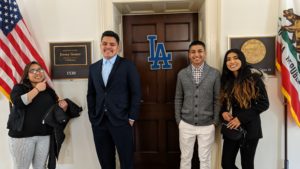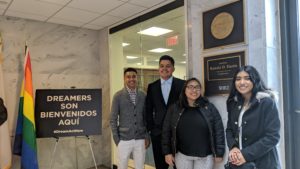
Karlo Silbiger is the Coordinator of College-Going Culture at the Partnership for Los Angeles Schools. He works with teachers, counselors, administrators, parents, and community partners at all 18 schools in the Partnership network to support students in preparing for and transitioning to college after graduation.
It’s June 2019. As you walk across the stage to get your high school diploma, the Principal asks about your plans for next year. Excitedly, you tell her that you’re going to California State University, Los Angeles – and that you’re the first in your family to attend college. Three weeks later, you receive an email from the Financial Aid office asking you to submit complicated income verification documents in order to verify your financial aid award. Your parents are nervous about sending sensitive information that could raise questions about how they earn money. You reach out to your counselor, but he’s out on summer break. You then look over your financial aid award and realize that the Pell Grant will only cover 28% of your expenses at best, leaving your family in a truly difficult situation. You have been dreaming about going to a four-year college for 13 years! But, in one stressful moment, you decide that maybe going to community college is easier than attempting to navigate the complicated world of financial aid alone.
Unfortunately, this scenario is not uncommon. In fact, college access experts predict that approximately 200,000 students per year are accepted to college and submit paperwork informing their chosen college of their intended matriculation, but never make it to the first day of school – a phenomenon known as “summer melt.” But summer melt can be eliminated if school district leaders and legislators take steps to address this unfortunate occurrence.
At the Partnership for Los Angeles Schools, we ensure that the voices of our students are heard loud and clear. In February, my colleague and I, along with four high school juniors from Partnership schools – Angel from Roosevelt High School; Stephanie from Math Science & Technology Magnet Academy (MSTMA) at Roosevelt; and Andrew and Kimberly from Santee Education Complex – participated in the two-day National College Access Network Advocacy convening in Washington, D.C. The students are all part of the Lundquist Fellows, a college-readiness leadership program sponsored by the Partnership for Los Angeles Schools. On the first day we joined about 130 other college access practitioners, high school students, and college students from 25 states to learn about barriers to college access that could be significantly improved with proper federal legislation, increasing access to federal financial aid. We heard from lead education deputies from the House and Senate committees, and also attended a writing workshop covering the best ways to share our stories with legislators and their staffs to better connect our individual experiences with legislative priorities.
The primary legislative goals we focused on during the convening were:
- Increase access to adequate federal money to support low-income students in funding their education (believe it or not, the Pell Grant only covers 28% of the average public college cost);
- Streamline the FAFSA (Free Application for Federal Student Aid) process to relieve the burden on first generation families, especially as it relates to income verification;
- Create better data systems so that we can hold accountable colleges that receive federal money for student success; and
- Provide ways for DACA (Deferred Action for Childhood Arrivals) students and other dreamers to access federal financial aid.
The following day, we met with representatives from the offices of our two California Senators, Senator Dianne Feinstein and Senator Kamala Harris, along with congressional representatives for Roosevelt and MSTMA, Congressman Jimmy Gomez, and Santee’s Congresswoman, Lucille Roybal-Allard. It was truly inspiring to hear our students powerfully speak about their college aspirations and how they expect to use their education to improve the lives of their families and communities. It was also important to hear them advocate for themselves and their communities with their elected representatives.
It is unfortunate that confusing bureaucratic hurdles can negatively impact our students’ future aspirations. Change is possible through awareness, advocacy, and empowerment. If these four students represent the willpower and creative thinking of their peers, which I believe they do, then we will soon have the leadership in power that we need to make four-year college access a reality for all.


